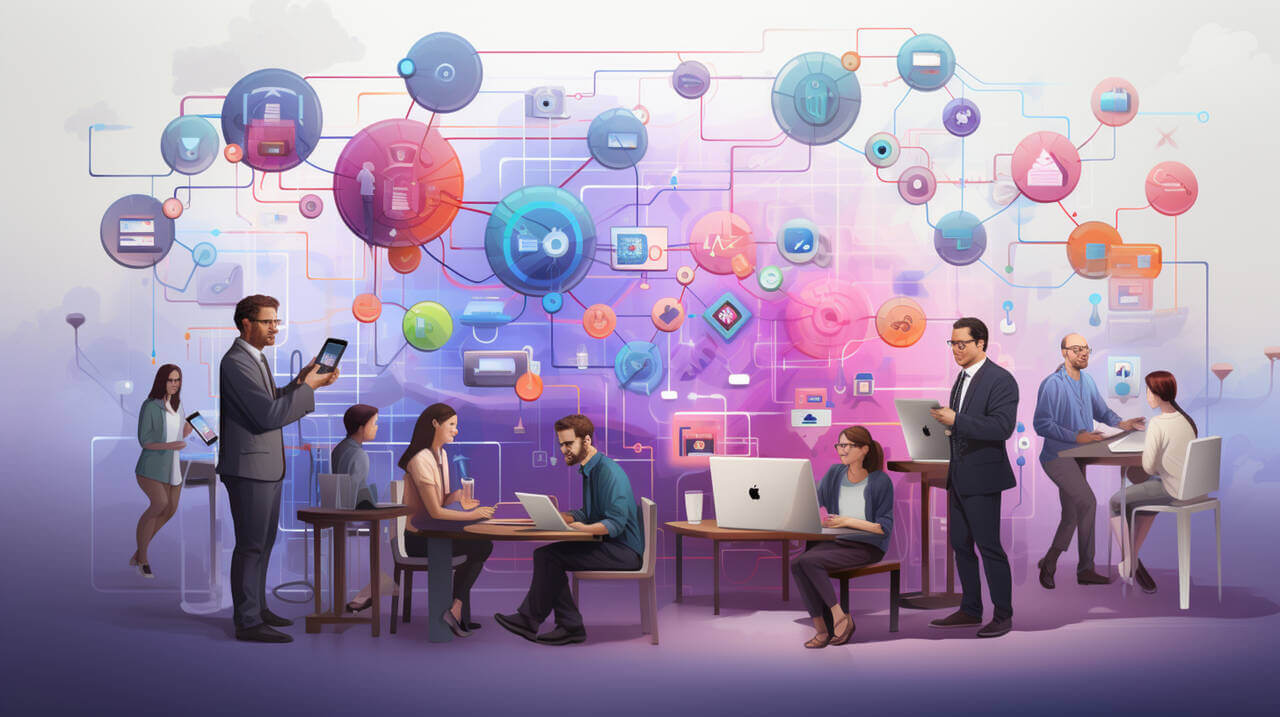
Ever heard the saying, "the only constant is change?" Businesses grapple with a central dilemma: adapting to innovation isn't just an advantage—it's a necessity. As technologies evolve at a breakneck speed and as consumer preferences and market dynamics shift like sand underfoot, organizations are finding that yesterday's expertise may not solve tomorrow's challenges.
Modern companies demand a workforce that is as agile as it is skilled and capable of riding the waves of change rather than being swept away by them. Up-to-date skillsets are the lifeblood of a competitive organization, ensuring relevance in a landscape where irrelevance is just one innovation away. However, many organizations don't understand or implement what it takes to keep their talent moving forward. They also rarely have the operational excellence to rework processes as fast as needed to match the improved productivity that updated skills provide.
Today, we'll be untangling the maze of modern innovation, uncovering why continuous skill development is not merely a strategic move but an imperative for survival. We'll examine how fostering a learning culture can propel your team forward and how falling behind on skill cultivation can mean losing ground to competitors. We'll outline how to transform the challenge of perpetual change into a tapestry of opportunity for your organization so you don't get left behind.
Identifying Skill Gaps
Identifying Skill Gaps
The first step towards keeping your team's skills up to date with the pace of innovation is to identify the existing skill gaps. Having a constant eye on shifts in the market while assessing internal corporate abilities to execute against the changing environment is key to keeping pace. Like many things in business, this is a continuous cycle operation in line with the 4 imPERAtives of business: Plan, Enact, Review, and Adapt.
Companies should check current customer or market requirements against existing skills to develop an improvement plan. Then, implement that plan to enact the change and report on the outcomes to review the plan's efficacy. Finally, adapt again based on that information and any further changes in the marketplace.
Recognizing the Necessity of Skill Gap Identification
Recognizing the Necessity of Skill Gap Identification
Without the necessary skills, your team is unlikely to be able to produce the level or quality of output that meets consumer demand. Skill gaps can be categorized into several areas:
Relevance: Once relevant skills may become outdated as technology and industry standards advance. Identifying and addressing these gaps ensures that your team's abilities remain pertinent.
Efficiency: Addressing skill gaps prevents inefficiencies and errors caused by a lack of necessary skills. It leads to smoother operations and improved productivity.
Innovation: Innovation often stems from a deeper understanding of emerging technologies or methodologies. Identifying skill gaps allows your team to access the skills necessary to embrace innovative ideas.
Competitiveness: In a competitive market, companies with the latest skills have a clear advantage. Recognizing skill gaps is crucial for maintaining or gaining prominence in your field.
Methods to Assess Skill Gaps
Methods to Assess Skill Gaps
Identifying skill gaps can be a challenging but rewarding process. There are various tools and methods available to assess the skills of your team comprehensively. Some of these include:
Skills Assessments:
Skills Assessments:
Utilize skills assessment tests or quizzes to gauge the proficiency of team members in specific areas. You can tailor these to assess technical skills, soft skills, or other relevant competencies. It's often essential to bring in outside experts to help develop, evaluate, and bring the team up to date with the skills they need to work effectively.

Peer Evaluations:
Peer Evaluations:
Colleagues often have a unique perspective on each other's strengths and weaknesses. Encouraging team members to provide anonymous feedback on their peers' abilities can help leadership identify areas to improve without gossip and division among team members who are fixing mistakes made by others. Remember to check with the operations team to ensure the claim being made isn't simply part of the trained or requested process. It's not always the individual who has the issue, but sometimes, the process needs to be updated to allow skills implementation.
Feedback Loops:
Feedback Loops:
Establish regular feedback mechanisms for managers and team members to discuss skill development needs. Constructive feedback on individual needs can reveal areas for improvement for the entire team.
Performance Reviews:
Performance Reviews:
Incorporate skill assessment into performance reviews. As a result, it can provide a structured framework for discussing skill gaps and setting goals for improvement. With scored models, the team members have more concrete goals to strive for, which provide clarity when other performance measures leave ambiguity and derision between team members and management.
External Consultants or Experts:
External Consultants or Experts:
Bringing in external experts can provide an unbiased evaluation of your team's skills. These experts can identify areas where your team can benefit from additional training or development. They can also help structure and provide the training and oversight necessary to implement new skills into daily processes and workflows.
Fostering a Positive Learning Environment
Fostering a Positive Learning Environment
Fostering a positive and playful atmosphere is crucial for enhancing organizational innovation. When employees encounter positivity while stumbling through challenging skills updates, it inspires them to think outside the box and develop creative solutions.
Positive feedback loops create an environment where ideas flow naturally, and team members are more willing to explore unconventional approaches to problem-solving. Additionally, in such an atmosphere, the fear of failure diminishes because failures are seen as opportunities for growth rather than a threat to one's livelihood. Keep in mind that there's a difference between a mistake and a habit when it comes to failure. Mistakes should be forgiven; habits need to be addressed.
When team members know you are supportive, they are less apprehensive about making mistakes or taking calculated risks, which is often a prerequisite for innovative breakthroughs. Furthermore, a workplace promotes collaboration as employees enjoy their work environment and feel valued. They are more likely to collaborate, share innovative ideas, and build upon one another's insights.
Positivity is not only a catalyst for innovation but also a significant asset when adapting to change and maintaining well-being. In transition and change, an optimistic outlook can help build emotional resilience. Team members are better equipped to cope with uncertainties and disruptions, leading to reduced stress and anxiety. Additionally, an upbeat atmosphere strengthens team cohesion, which is invaluable when navigating change. Teams that share a sense of unity and positivity are more likely to support each other, collectively address adaptation challenges, and navigate change more effectively.
Furthermore, positivity strongly links to well-being and job satisfaction. In an uplifting workplace culture, employees typically experience higher well-being and job satisfaction. This contentment translates into increased motivation and productivity, even in the face of change.
Lastly, positivity enhances adaptability, fostering a "can-do" attitude essential when dealing with new technologies, evolving market conditions, or changing customer preferences. It enables teams to remain flexible and open to change, staying competitive and resilient in an ever-evolving business landscape.
Maintaining a team-friendly and playful atmosphere not only ignites innovation but also equips teams to confront change with grace and take care of their well-being. Such an environment promotes personal and organizational growth, ultimately enabling businesses to stay competitive even through challenging environments.

Recruiting and Hiring for Innovation
Recruiting and Hiring for Innovation
Recruiting and hiring for innovation is the linchpin of cultivating a forward-thinking business environment. A company is only as good as its worst-performing employees, and in the realm of innovation, this means assembling a team with the vision to see beyond the horizon and the acumen to navigate uncharted waters. Companies that prioritize hiring for innovation are investing in their evolution and relevance. When it comes to recruiting and hiring for innovation, there are key elements to consider:
Diverse Perspectives:
Diverse Perspectives:
Innovation thrives on diversity. Teams with a rich tapestry of backgrounds, experiences, and ways of thinking can outmaneuver monolithic ones. When hiring, look for candidates who bring different perspectives to the table. Ensure your team has a wide range of industry experience, educational backgrounds, and problem-solving approaches. The clash and melding of ideas from these varied viewpoints often ignite the spark of innovation when managed correctly.
Intrinsic Motivation and Adaptability:
Intrinsic Motivation and Adaptability:
Seek individuals who show an intrinsic motivation to learn and adapt. The will to innovate must come from within; it cannot be imposed. During the interview process, explore how candidates have adapted to change in the past and how they pursue learning independently. Employees who demonstrate a propensity for self-motivated growth are more likely to contribute to an innovative culture.
Skillset and Mindset:
Skillset and Mindset:
While the right skillset is vital, the mindset that accompanies it is what makes it potent. Candidates who display a combination of critical thinking, creativity, and the ability to question established norms are often those who will push the envelope and drive innovation. During recruitment, assess not only what candidates can do but also how they think and approach problems.
Creating a Culture that Attracts Talent:
Creating a Culture that Attracts Talent:
Innovation-centric hiring is not just about evaluating candidates; it's also about building an organizational culture that attracts ingenious minds. Companies known for their innovative practices, learning opportunities, and dynamic approach to business are more likely to draw in candidates who are natural innovators.
How to Recruit for Innovation:
How to Recruit for Innovation:
To effectively recruit for innovation, companies need to:
Redefine Job Descriptions:
Redefine Job Descriptions:
Create job postings that speak to innovative minds. Highlight opportunities for creativity, autonomy, and the potential for impact within the role. Use language that resonates with those looking for more than just a job but a chance to make a difference.
Utilize New Recruitment Channels:
Utilize New Recruitment Channels:
Innovators aren't always found through traditional channels. Explore niche forums, social media groups, hackathons, and industry meetups to find talent already engaged in innovative activities.
Incorporate Scenario-Based Interviews:
Incorporate Scenario-Based Interviews:
Move beyond the resume and assess how candidates perform in real-world scenarios. Presenting problems that require creative solutions can reveal a candidate's innovative potential.
Emphasize Growth and Development Opportunities:
Emphasize Growth and Development Opportunities:
During the recruitment process, emphasize the company's commitment to professional growth and development, which is critical for keeping innovative team members engaged and continuously learning.
Leverage Current Innovators:
Leverage Current Innovators:
Involve your current innovators in the hiring process. They can help identify the traits that make them successful and assess whether candidates possess a similar innovative spark. By implementing these strategies, businesses can not only recruit individuals who are predisposed to innovation but also foster an environment where innovation is the expected norm. Innovation paves the way for an organizational culture where continuous improvement is ingrained and where staying ahead of the curve is just business as usual rather than something to dread.
Establishing Dedicated Teaching Resources
To ensure your team can successfully keep up with that much change, the need for dedicated teachers within each team and specific subject areas is vital. These instructors, who can include experienced team members or leaders as well as outside experts, bring knowledge and expertise to the learning process. They understand the nuances of their respective subjects, the challenges that team members face, and the practical applications of the skills in question.
This cultivated expertise ensures that the teaching is not only accurate but also tailored to the specific needs of the team. Additionally, these dedicated teachers foster a culture of continuous learning within the organization. They serve as mentors, guiding team members in their skill development journeys. They provide insights, answer questions, and offer real-world examples that make learning more relatable and effective. Furthermore, teachers can adapt their teaching methods to suit the learning styles and pace of individual team members, creating a personalized and supportive learning environment.
Dedicated resources, serving as teachers within each team and subject area, are pivotal in bridging the skill gaps identified within an organization. These experts offer several advantages:

Tailored Guidance:
Tailored Guidance:
Dedicated teachers understand the specific skill gaps within their teams and can tailor their guidance to address these deficiencies effectively. They can focus on the areas where improvement is most needed, offering a highly targeted learning experience.
Real-World Relevance:
Real-World Relevance:
With their hands-on experience, these instructors can provide real-world examples and case studies demonstrating the practical applications of the skills in question. It not only bridges the knowledge gap but also helps team members see the value in what they are learning.
Immediate Feedback:
Immediate Feedback:
In-house instructors are readily available for questions and immediate feedback. This timely assistance accelerates the learning process and ensures team members can quickly address their doubts and concerns.
Mentorship and Support:
Mentorship and Support:
Beyond teaching, these dedicated resources can serve as mentors, offering ongoing support and encouragement. They can guide team members on their learning journeys, helping them set goals and track progress.
Personalized Learning:
Personalized Learning:
Instructors who are team members or leaders can adapt their teaching to the unique learning styles and needs of their colleagues. This personalized approach enhances the effectiveness of skill development. Building dedicated resources bridges the existing skill gaps with the knowledge and experience required to fill them. This role is pivotal in ensuring team members receive the targeted guidance and support they need to enhance their skills, making the organization more competitive and adaptable in a rapidly changing business landscape.
Allocating Dedicated Time for Learning and Innovation
Allocating Dedicated Time for Learning and Innovation
Setting aside dedicated time for learning and innovation is a fundamental practice for organizations building a workforce around continuous innovation. Requiring set aside time underscores the deliberate and strategic nature of these activities, making it clear that continuous learning and innovation are not incidental but vital components of the company's ethos. Moreover, this designated time communicates the organization's commitment to fostering adaptability and competitiveness. It sends a powerful message to employees, emphasizing the value of growth and creativity. Thus, it can enhance morale and contribute to improved employee retention.
Beyond that, dedicating time to these pursuits allows employees to step away from their daily tasks, providing a fresh perspective and a break from routine. Such a shift in focus encourages creative thinking and can lead to innovative solutions to existing challenges. It also creates an environment in which employees feel safe to experiment, take calculated risks, and, at times, even fail – an essential element of genuine innovation.
The allocation of dedicated time offers a wealth of opportunities. It permits employees to explore new technologies, methodologies, and processes systematically. During these designated periods, employees can stay updated with the latest technologies and industry trends, ensuring their skills remain contemporary and applicable. It provides a platform for experimentation and testing, enabling employees to assess new tools, technologies, and methodologies without the pressure of immediate deliverables. This freedom to experiment often leads to discovering more efficient or innovative approaches to tasks and challenges.
Dedicated time can also be harnessed for problem-solving, as employees can brainstorm, research, and test potential solutions. It encourages cross-training, where employees broaden their skill sets by learning from one another or acquiring expertise in areas outside their typical responsibilities. Furthermore, it fosters collaboration and knowledge sharing among team members, allowing them to collaborate to explore new technologies and methodologies while leveraging their collective expertise.

Focusing on Operational Excellence and ROI
Focusing on Operational Excellence and ROI
As you're embedding a continuous improvement culture in your workforce, you need to follow that up with operational excellence to enable that level of change. Operations excellence is the backbone that ensures all activities, including education and innovation, run efficiently and smoothly. When processes and operations are optimized, it frees up time and resources, creating a conducive environment for employees to engage in learning and innovation without unnecessary bottlenecks. Change can only happen if the skills and processes identified during assessment and training apply to a worker's daily activities. The longer you wait between training and application, the enthusiasm for learning and continuous improvement will decline, and the less likely the skills will be put to use or sharpened.
A culture of operational excellence promotes accountability, problem-solving, and the elimination of waste, all of which are essential elements in nurturing a culture of continuous improvement and innovation. Moreover, it allows for the seamless integration of newly acquired skills and innovative solutions into everyday practices, enabling the organization to adapt and thrive in an ever-evolving business landscape.
Focusing on Return on Investment (ROI) is a critical strategy to ensure that the resources allocated for skill development achieve the highest efficiency. ROI tracking provides a structured framework for evaluating the effectiveness of investments in learning and development. By tracking the impact of skill development initiatives, organizations can assess whether the resources invested translate into tangible benefits. Thus, this not only safeguards against wasteful spending but also encourages a data-driven approach to decision-making, ensuring that training programs align with strategic goals.
Additionally, a focus on ROI promotes accountability and the continual improvement of training methods, ensuring skill development efforts continually improve to maximize their impact. This strategic approach not only ensures that resources are used efficiently but also reinforces the organization's commitment to learning and innovation as an essential driver of long-term success.
Leverage Continuous Learning and Innovation to Keep Up with the Pace of Change
Leverage Continuous Learning and Innovation to Keep Up with the Pace of Change
From hiring individuals who align with the company's mission to creating a culture of continuous learning, every step contributes to staying competitive in an ever-evolving world. Investing in the skills, mindset, and resources that enable innovation is not just a strategic choice but a survival imperative. The financial benefits cannot be understated; it's not merely an expense but an investment that pays substantial dividends. By nurturing a workforce that's mission-driven, well-equipped, and adaptable, your organization not only stays relevant but also significantly boosts its Return on Investment (ROI).
These investments in continuous learning and innovation lead to more efficient operations, enhanced problem-solving, and a workforce better prepared to meet the challenges of the ever-evolving business landscape.

